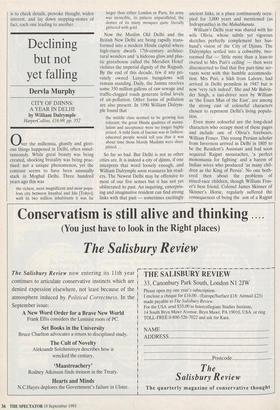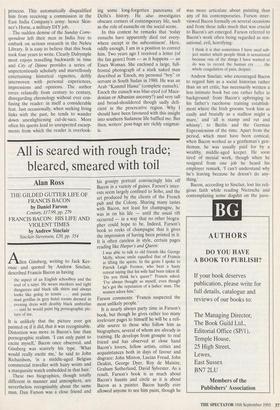Declining but not yet falling
Deryla Murphy
CITY OF DJINNS: A YEAR IN DELHI by William Dalrymple HarperCollins, £16.99, pp. 352 Over the millennia, ghastly and glori- ous things happened in Delhi, often simul- taneously. While great beauty was being created, shocking brutality was being prac- tised: not a unique phenomenon, yet the contrast seems to have been unusually stark in Moghul Delhi. Three hundred years ago this was
the richest, most magnificent and most popu- lous city between Istanbul and Ido [Tokyo]; with its two million inhabitants it was far larger than either London or Paris. Its army was invincible, its palaces unparalleled, the domes of its many mosques quite literally glittered with gold.
Now the Muslim Old Delhi and the British New Delhi are being rapidly trans- formed into a modern Hindu capital where high-risery dwarfs 17th-century architec- tural wonders and `a hideous glass and plas- tic greenhouse called the Meridien Hotel' violates the imperial dignity of the Raj path. By the end of this decade, few if any pri- vately owned Lutyens bungalows will remain standing. Daily, the Jumna receives some 350 million gallons of raw sewage and traffic-clogged roads generate lethal levels of air-pollution. Other forms of pollution are also present. In 1990 William Dalrym- ple found that
the middle class seemed to be growing less tolerant; the great Hindu qualities of assimi- lation and acceptance were no longer highly prized. A mild form of fascism was in fashion: educated people would tell you that it was about time those bloody Muslims were disci- plined...
So far so bad. But Delhi is not as other cities are. It is indeed a city of djinns, if one interprets that word loosely enough, and William Dalrymple soon reassures his read- ers. The Newest Delhi may be offensive to most of our five senses but it has not yet obliterated its past. An inquiring, enterpris- ing and imaginative resident can find strong links with that past — sometimes excitingly
ancient links, in a place continuously occu- pied for 3,000 years and mentioned (as Indraprastha) in the Mahabharata.
William's Delhi year was shared with his wife Olivia, whose subtle yet vigorous sketches perfectly complement her hus- band's vision of the City of Djinns. The Dalrymples settled into a cobwebby, two- roomed flat — `little more than a lean-to riveted to Mrs Puri's ceiling' — then were disconcerted to find that five part-time ser- vants went with this humble accommoda- tion. Mrs Puri, a Sikh from Lahore, had arrived in Delhi penniless in 1947 but is now `very rich indeed'. She and Mr Balvin- der Singh, a taxi-driver seen by William as `the Essex Man of the East', are among the strong cast of colourful characters chosen to represent Delhi's living popula- tion.
Even more colourful are the long-dead characters who occupy most of these pages and include one of Olivia's forebears, William Fraser. This young Persian scholar from Inverness arrived in Delhi in 1805 to be the Resident's Assistant and had soon acquired Rajput moustaches, `a perfect monomania for fighting' and a harem of Indian wives who produced 'as many chil- dren as the King of Persia'. No one both- ered then about the problems of mixed-race children, though William Fras- er's best friend, Colonel James Skinner of Skinner's Horse, regularly suffered the consequences of being the son of a Rajput princess. This automatically disqualified him from receiving a commission in the East India Company's army: hence Skin- ner's Horse, a military DIY job.
The sudden demise of the Sunday Corre- spondent left their man in India free to embark on serious research in the Nehru Library. It is easy to believe that this book took four years to write. Clearly Dalrymple most enjoys travelling backwards in time and City of Djinns provides a series of unpretentiously scholarly and marvellously entertaining historical vignettes, deftly interwoven with personal experiences, impressions and opinions. The author roves relaxedly from century to century, disregarding chronology without ever con- fusing the reader: in itself a considerable feat. Just occasionally, when seeking living links with the past, he tends to wander down unenlightening cul-de-sacs. More often his quests lead to unexpected escarp- ments from which the reader is overlook-
ing some long-forgotten panorama of Delhi's history. He also investigates obscure corners of contemporary life, such as the role of eunuchs on the social scene.
In this context he remarks that 'today eunuchs have apparently died out every- where except in the subcontinent'. Here, oddly enough, I am in a position to correct him. Two years ago I received a letter (of the fan genre) from — as it happens — an Essex Woman. She enclosed a large, full- frontal photograph of a stark naked man described as 'Enoch, my personal "boy" or servant in South Sudan in 1988. He was an Arab "Kammil Hassa" (complete eunuch).' Enoch the eunuch was blue-eyed (of Mace- donian or Albanian ancestry?) and very tall and broad-shouldered though sadly defi- cient in the procreative region. Why I should have been favoured with this insight into southern Sudanese life baffled me. But then, writers' post-bags are richly enigmat- ic.



































































 Previous page
Previous page